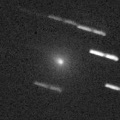
|
Now it is 11.7 mag (Feb. 10, Chris Wyatt). It stays as bright as 11 mag from January to February. In the Northern Hemisphere, it stays observable for a long time in the evening sky. In the Southern Hemisphere, it will be getting higher gradually.
Date(TT) R.A. (2000) Decl. Delta r Elong. m1 Best Time(A, h)
Feb. 17 1 3.81 1 15.8 1.328 0.981 47 11.1 19:08 ( 71, 27)
Feb. 24 1 38.55 3 9.1 1.333 1.017 49 11.3 19:14 ( 73, 28)
|
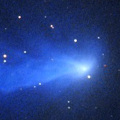
|
Now it is 11.8 mag (Feb. 15, Danil Sidorko). It will stay bright as 11 mag for a long time until spring. In the Southern Hemisphere, it will be unobservable in March. In the Northern Hemispehre, it stays observable for a long time after this until the comet fades out.
Date(TT) R.A. (2000) Decl. Delta r Elong. m1 Best Time(A, h)
Feb. 17 3 58.69 27 19.0 2.472 2.742 95 11.3 19:08 ( 63, 75)
Feb. 24 4 0.46 29 4.1 2.554 2.720 88 11.4 19:14 ( 79, 70)
|
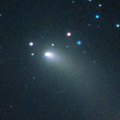
|
Now it is very bright as 9.8 mag (Feb. 10, Carlos Labordena). It will go far away from Earth after this. But it will approach to Sun down to 0.58 a.u. on Feb. 21. In the Northern Hemisphere, it stays extremely low after this. In the Southern Hemisphere, it is not observable until late March.
Date(TT) R.A. (2000) Decl. Delta r Elong. m1 Best Time(A, h)
Feb. 17 21 39.41 18 23.8 1.146 0.590 31 11.6 5:19 (250, 4)
Feb. 24 21 36.27 13 43.8 1.263 0.583 26 11.7 5:12 (257, 6)
|
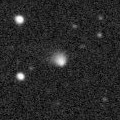
|
Now it is 12.1 mag (Feb. 17, Juan Jose Gonzalez). It stays 12 mag for a long time until spring in 2019. In the Northern Hemisphere, it stays observable in good condition while the comet will be brightening gradually. In the Southern Hemisphere, it is not observable until October.
Date(TT) R.A. (2000) Decl. Delta r Elong. m1 Best Time(A, h)
Feb. 17 15 18.21 72 3.0 2.693 3.097 104 12.5 5:19 (182, 53)
Feb. 24 14 49.46 75 28.7 2.646 3.061 105 12.4 4:35 (180, 50)
|
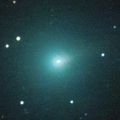
|
It brightened up to 9.2 mag from November to December (Nov. 16, Juan Jose Gonzalez). Now it is fading. But it is bright as 12.4 mag still now (Feb. 10, Chris Wyatt). It stays observable in good condition until summer when it fades out.
Date(TT) R.A. (2000) Decl. Delta r Elong. m1 Best Time(A, h)
Feb. 17 14 27.85 2 0.2 1.066 1.715 113 12.7 4:41 ( 0, 57)
Feb. 24 14 31.17 2 22.2 1.049 1.758 119 13.0 4:17 ( 0, 57)
|
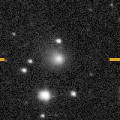
|
Now it is bright as 12.0 mag (Feb. 12, Thomas Lehmann). It is expected to brighten up to 10 mag in summer. In the Northern Hemisphere, it stays observable until summer while the comet will be brightening. It is appear in the morning sky also in the Southern Hemisphere.
Date(TT) R.A. (2000) Decl. Delta r Elong. m1 Best Time(A, h)
Feb. 17 19 3.05 2 24.9 3.545 2.953 46 13.2 5:19 (287, 26)
Feb. 24 19 9.24 1 40.7 3.428 2.904 50 13.1 5:12 (290, 29)
|

|
It is not observable now. It will appear in the morning sky in late March in the Southern Hemisphere, or in late April in the Northern Hemisphere.
Date(TT) R.A. (2000) Decl. Delta r Elong. m1 Best Time(A, h)
Feb. 17 22 10.24 -8 23.2 6.779 5.794 4 13.9 19:08 ( 90,-14)
Feb. 24 22 15.64 -7 48.6 6.781 5.793 3 13.9 5:12 (269,-15)
|

|
It brightened up to 7.1 mag from May to June in 2017 (June 21, Juan Jose Gonzalez). Now it is fading. It has already faded down to 12.9 mag (Jan. 17, Chris Wyatt). In the Southern Hemisphere, it stays observable for a long time after this. However, it will be extremely low from January to March. It will never be observable again in the Northern Hemisphere.
Date(TT) R.A. (2000) Decl. Delta r Elong. m1 Best Time(A, h)
Feb. 17 22 55.94 -48 56.2 4.185 3.467 38 14.0 19:08 ( 47,-26)
Feb. 24 23 10.09 -48 6.2 4.241 3.534 39 14.1 19:14 ( 49,-28)
|
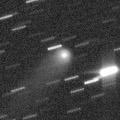
|
Now it is very bright as 12.1 mag (Feb. 16, Toshihiko Ikemura, Hirohisa Sato). It will be observable at 13-14 mag for a long time from 2017 to 2018. In the Southern Hemisphere, it will be hardly observable after this.
Date(TT) R.A. (2000) Decl. Delta r Elong. m1 Best Time(A, h)
Feb. 17 16 32.90 34 53.2 3.588 3.730 90 14.1 5:19 (264, 72)
Feb. 24 16 28.94 37 22.3 3.501 3.730 95 14.0 5:12 (255, 77)
|
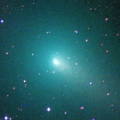
|
It brightened up to 8.1 mag in autumn (Oct. 3, Juan Jose Gonzalez). Now it is fading. It has already faded down to 16.6 mag (Feb. 13, Toshihiko Ikemura, Hirohisa Sato). In the Northern Hemisphere, it stays observable in good condition for a long time. In the Southern Hemisphere, it will never be observable again after this.
Date(TT) R.A. (2000) Decl. Delta r Elong. m1 Best Time(A, h)
Feb. 17 5 43.12 78 34.4 1.758 2.253 106 14.5 19:58 (180, 47)
Feb. 24 6 10.88 76 33.0 1.853 2.319 105 14.8 19:58 (180, 49)
|
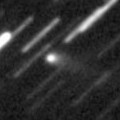
|
Now it is 13.8 mag (Feb. 10, Chris Wyatt). It stays 14 mag for a while. It stays observable in the evening sky until spring.
Date(TT) R.A. (2000) Decl. Delta r Elong. m1 Best Time(A, h)
Feb. 17 2 45.24 -12 7.2 2.207 2.075 69 14.7 19:08 ( 40, 34)
Feb. 24 2 55.09 -8 3.7 2.297 2.099 65 14.8 19:14 ( 48, 34)
|
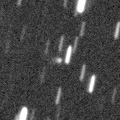
|
Now it is 15.8 mag (Feb. 18, Toshihiko Ikemura, Hirohisa Sato). It will brighten up to 9 mag in summer. However, it is hardly observable when it is bright. In the Northern Hemisphere, it is observable only until March when it brightens up to 14 mag. In the Southern Hemisphere, it is observable from July to September, but it locates in extremely low.
Date(TT) R.A. (2000) Decl. Delta r Elong. m1 Best Time(A, h)
Feb. 17 0 8.38 43 37.1 2.856 2.562 62 15.4 19:08 (122, 35)
Feb. 24 0 21.84 42 2.7 2.852 2.474 57 15.2 19:14 (122, 31)
|
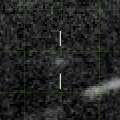
|
Now it is 17.2 mag (Jan. 14, iTelescope Observatory, Siding Spring). It will be observable at 14 mag in good condition from spring to summer.
Date(TT) R.A. (2000) Decl. Delta r Elong. m1 Best Time(A, h)
Feb. 17 18 2.57 -30 40.4 2.091 1.773 57 15.6 5:19 (322, 12)
Feb. 24 18 24.76 -30 33.5 2.017 1.746 59 15.4 5:12 (322, 12)
|
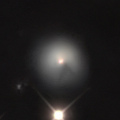
|
Brian Skiff found a bright outburst on Dec. 7. It brightened up to 13.2 mag (Dec. 11, Seiichi Yoshida). It stays bright as 14.6 mag still now (Jan. 19, Sandor Szabo). This is the 4th outburst following those in January 2006, May 2011 and August 2016. It stays observable in good condition for a while.
Date(TT) R.A. (2000) Decl. Delta r Elong. m1 Best Time(A, h)
Feb. 17 2 42.20 12 4.3 7.689 7.476 73 15.7 19:08 ( 62, 52)
Feb. 24 2 44.68 12 17.9 7.817 7.494 67 15.9 19:14 ( 69, 46)
|

|
Now it is 16.2 mag (Feb. 13, Toshihiko Ikemura, Hirohisa Sato). It stays 16-17 mag for a long time from 2016 to 2019. It stays near by the equator.
Date(TT) R.A. (2000) Decl. Delta r Elong. m1 Best Time(A, h)
Feb. 17 10 27.41 5 53.8 8.621 9.598 170 15.8 0:42 ( 0, 61)
Feb. 24 10 25.84 6 13.9 8.614 9.601 176 15.8 0:13 ( 0, 61)
|
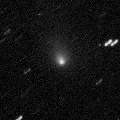
|
It brightened very rapidly up to 13.8 mag in August (Aug. 22, kunihiro Shima). After that, it is fading gradually. Now it is 15.9 mag (Feb. 13, Toshihiko Ikemura, Hirohisa Sato). It will be unobservable in March.
Date(TT) R.A. (2000) Decl. Delta r Elong. m1 Best Time(A, h)
Feb. 17 1 21.12 -4 34.2 2.744 2.242 50 15.9 19:08 ( 64, 26)
Feb. 24 1 32.35 -2 27.5 2.789 2.226 46 15.9 19:14 ( 69, 23)
|
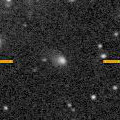
|
Now it is 16.3 mag (Feb. 18, Toshihiko Ikemura, Hirohisa Sato). It is expected to brighten up to 13-14 mag from 2018 to 2019. In the Northern Hemisphere, it stays observable in good condition for a long time. In the Southern Hemisphere, it is not observable until summer in 2018.
Date(TT) R.A. (2000) Decl. Delta r Elong. m1 Best Time(A, h)
Feb. 17 19 30.07 38 39.6 4.874 4.492 61 16.0 5:19 (245, 38)
Feb. 24 19 33.18 38 53.3 4.807 4.450 63 15.9 5:12 (246, 41)
|

|
It stays 15 mag from 2018 to 2019, and it will be observable for a long time in the Southern Hemisphere. In the Northern Hemisphere, it will never be observable again.
Date(TT) R.A. (2000) Decl. Delta r Elong. m1 Best Time(A, h)
Feb. 17 14 11.88 -57 4.8 4.762 4.927 93 16.0 4:26 ( 0, -2)
Feb. 24 14 11.14 -58 36.5 4.650 4.892 98 15.9 3:58 ( 0, -4)
|

|
Now it is 16.0 mag (Feb. 12, Toshihiko Ikemura, Hirohisa Sato). It will be observable at 16 mag in good condition from winter to spring.
Date(TT) R.A. (2000) Decl. Delta r Elong. m1 Best Time(A, h)
Feb. 17 11 55.55 10 14.5 2.636 3.537 151 16.0 2:10 ( 0, 65)
Feb. 24 11 52.23 10 45.0 2.595 3.538 159 15.9 1:39 ( 0, 66)
|
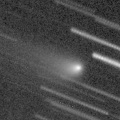
|
Appearing in the morning sky. It is fading now. But it stays 16 mag until summer.
Date(TT) R.A. (2000) Decl. Delta r Elong. m1 Best Time(A, h)
Feb. 17 19 24.10 -21 10.0 3.960 3.246 38 16.1 5:19 (302, 7)
Feb. 24 19 24.40 -21 27.1 3.901 3.284 45 16.1 5:12 (305, 10)
|
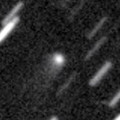
|
Now it is 15.9 mag (Feb. 12, Toshihiko Ikemura, Hirohisa Sato). It stays 16 mag for a long time from 2017 to 2018. It is observable in excellent condition in the Northern Hemisphere. It locates very low in the Southern Hemisphere.
Date(TT) R.A. (2000) Decl. Delta r Elong. m1 Best Time(A, h)
Feb. 17 7 46.05 41 32.6 4.586 5.366 138 16.1 21:56 (180, 83)
Feb. 24 7 37.75 42 13.8 4.675 5.372 130 16.2 21:21 (180, 83)
|

|
Now it is 16.9 mag (Jan. 15, Alexander Baransky). It stays 17 mag in 2018.
Date(TT) R.A. (2000) Decl. Delta r Elong. m1 Best Time(A, h)
Feb. 17 3 19.02 0 55.4 6.697 6.597 80 16.3 19:08 ( 39, 49)
Feb. 24 3 21.60 1 18.3 6.833 6.628 73 16.4 19:14 ( 49, 45)
|
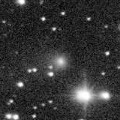
|
Now it is 16.1 mag (Feb. 18, Toshihiko Ikemura, Hirohisa Sato). It will be fading after this. In the Northern Hemisphere, it stays observable in the northern sky for a long time. It is not observable at all after this in the Southern Hemisphere.
Date(TT) R.A. (2000) Decl. Delta r Elong. m1 Best Time(A, h)
Feb. 17 21 5.38 69 32.6 3.511 3.518 82 16.3 5:19 (204, 33)
Feb. 24 21 16.73 71 17.5 3.548 3.545 81 16.4 5:12 (203, 34)
|
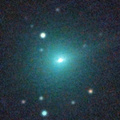
|
It brightened up to 9.7 mag in November (Nov. 16, Juan Jose Gonzalez). Now it is fading rapidly. It has already faded down to 13.0 mag (Feb. 10, Chris Wyatt).
Date(TT) R.A. (2000) Decl. Delta r Elong. m1 Best Time(A, h)
Feb. 17 16 21.92 -11 5.2 1.479 1.670 82 16.6 5:19 (335, 40)
Feb. 24 16 31.31 -11 32.3 1.464 1.726 87 16.9 5:12 (339, 41)
|

|
It will brighten up to 16 mag in spring. In the Southern Hemisphere, it stays observable until August, but it will be unobservable after that. In the Northern Hemisphere, it stays unobservable until June, but it will be observable in good condition after that.
Date(TT) R.A. (2000) Decl. Delta r Elong. m1 Best Time(A, h)
Feb. 17 18 32.57 -47 35.6 1.921 1.593 55 16.8 5:19 (328, -5)
Feb. 24 19 8.16 -47 38.1 1.849 1.542 56 16.6 5:12 (326, -6)
|
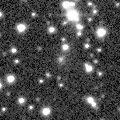
|
Now it is 16.6 mag (Feb. 13, Toshihiko Ikemura, Hirohisa Sato). It will pass the perihelion in 2019. However, it has not been brightening since the discovery in 2010. It is observable in good conditioin in the Northern Hemisphere. It is not observable for a long time in the Southern Hemisphere.
Date(TT) R.A. (2000) Decl. Delta r Elong. m1 Best Time(A, h)
Feb. 17 5 39.08 75 47.3 8.379 8.730 107 16.8 19:52 (180, 49)
Feb. 24 5 38.26 75 25.9 8.432 8.720 103 16.8 19:23 (180, 50)
|
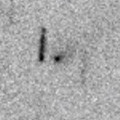
|
Now it is 17.4 mag (Feb. 13, Toshihiko Ikemura, Hirohisa Sato). It will be fading after this, and will be fainter than 18 mag in April.
Date(TT) R.A. (2000) Decl. Delta r Elong. m1 Best Time(A, h)
Feb. 17 9 37.63 -15 58.2 2.234 3.137 151 16.9 23:47 ( 0, 39)
Feb. 24 9 33.62 -15 55.2 2.272 3.175 151 17.0 23:16 ( 0, 39)
|

|
Now it is 16.1 mag (Feb. 18, Toshihiko Ikemura, Hirohisa Sato). It will be fading gradually after this, and it will be fainter than 18 mag in autumn. In the Northern Hemisphere, it stays observable in good condition for a long time. In the Southern Hemisphere, it will never be observable again.
Date(TT) R.A. (2000) Decl. Delta r Elong. m1 Best Time(A, h)
Feb. 17 20 58.05 60 54.5 7.112 6.908 74 17.0 5:19 (214, 31)
Feb. 24 21 9.29 61 25.8 7.157 6.928 72 17.0 5:12 (214, 32)
|
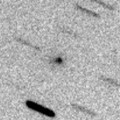
|
Now it is 18.5 mag (Feb. 12, Toshihiko Ikemura, Hirohisa Sato). It stays observable at 17 mag in good condition for a while. It will be fainter than 18 mag in May.
Date(TT) R.A. (2000) Decl. Delta r Elong. m1 Best Time(A, h)
Feb. 17 15 12.73 -7 58.1 2.051 2.425 99 17.1 5:19 (358, 47)
Feb. 24 15 17.21 -7 50.0 1.998 2.459 105 17.1 5:03 ( 0, 47)
|
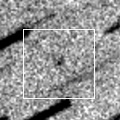
|
Now it is 17.6 mag (Feb. 18, Martin Masek). It will brighten rapidly after this, and will brighten up to 12 mag from April to June. In the Southern Hemisphere, it stays observable in excellent condition. In the Northern Hemisphere, it will be unobservable from April to June when the comet becomes brightest.
Date(TT) R.A. (2000) Decl. Delta r Elong. m1 Best Time(A, h)
Feb. 17 16 15.99 -25 14.9 1.595 1.747 81 17.6 5:19 (342, 28)
Feb. 24 16 36.92 -27 25.8 1.487 1.691 83 17.3 5:12 (343, 25)
|
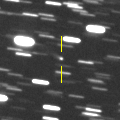
|
Now it is 17.4 mag (Feb. 12, Toshihiko Ikemura, Hirohisa Sato). It stays observable at 18 mag for a long time until 2019.
Date(TT) R.A. (2000) Decl. Delta r Elong. m1 Best Time(A, h)
Feb. 17 5 39.35 16 50.4 7.445 7.940 116 17.4 19:50 ( 0, 72)
Feb. 24 5 36.14 16 40.7 7.560 7.938 109 17.4 19:20 ( 0, 72)
|
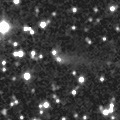
|
Now it is 18.0 mag (Feb. 18, Toshihiko Ikemura, Hirohisa Sato). It will be fading after this, and will be fainter than 18 mag in March. It is observable in excellent condition in the Northern Hemisphere. It locates low in the Southern Hemisphere.
Date(TT) R.A. (2000) Decl. Delta r Elong. m1 Best Time(A, h)
Feb. 17 5 5.36 33 56.7 2.952 3.419 110 17.6 19:17 ( 0, 89)
Feb. 24 5 9.15 33 42.0 3.067 3.442 103 17.7 19:14 ( 75, 85)
|
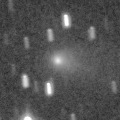
|
It brightened up to 14.8 mag from autumn to winter (Nov. 21, Hiroshi Abe). Now it is fading. It has already faded down to 17.1 mag (Feb. 12, Toshihiko Ikemura, Hirohisa Sato). It is observable in good condition in the Northern Hemisphere. It locates low in the Southern Hemisphere.
Date(TT) R.A. (2000) Decl. Delta r Elong. m1 Best Time(A, h)
Feb. 17 5 15.35 37 21.7 1.862 2.414 112 17.6 19:27 (180, 88)
Feb. 24 5 22.73 36 57.1 1.973 2.449 106 17.9 19:14 (143, 88)
|
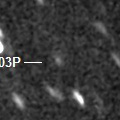
|
Now it is 18.4 mag (Jan. 15, Toshihiko Ikemura, Hirohisa Sato). It will be fading slowly after this.
Date(TT) R.A. (2000) Decl. Delta r Elong. m1 Best Time(A, h)
Feb. 17 11 46.69 -13 24.8 2.446 3.292 143 17.6 2:01 ( 0, 41)
Feb. 24 11 40.95 -12 50.8 2.438 3.339 151 17.7 1:28 ( 0, 42)
|
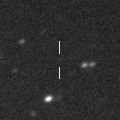
|
It is observable at 17.5 mag in good condition from February to April. However, now it is 18.7 mag (Feb. 13, Toshihiko Ikemura, Hirohisa Sato), fainter than predicted.
Date(TT) R.A. (2000) Decl. Delta r Elong. m1 Best Time(A, h)
Feb. 17 12 1.66 -7 57.5 1.877 2.737 143 17.7 2:16 ( 0, 47)
Feb. 24 11 59.45 -7 33.5 1.825 2.735 151 17.7 1:46 ( 0, 47)
|
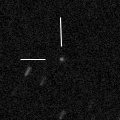
|
Now it is 17.3 mag (Feb. 13, Toshihiko Ikemura, Hirohisa Sato). It will brighten up to 15.5 mag in January, 2019. It stays observable in excellent condition in the Northern Hemispehre. It is observable only until June, 2018, in the Southern Hemisphere.
Date(TT) R.A. (2000) Decl. Delta r Elong. m1 Best Time(A, h)
Feb. 17 12 41.62 16 14.3 3.654 4.464 140 17.8 2:56 ( 0, 71)
Feb. 24 12 34.23 18 14.1 3.551 4.423 148 17.7 2:21 ( 0, 73)
|
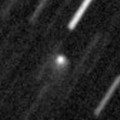
|
Now it is 17.5 mag (Feb. 18, Toshihiko Ikemura, Hirohisa Sato). It is observable at 18 mag in good condition from winter to spring.
Date(TT) R.A. (2000) Decl. Delta r Elong. m1 Best Time(A, h)
Feb. 17 12 36.98 12 21.6 4.653 5.465 141 17.7 2:51 ( 0, 67)
Feb. 24 12 31.73 13 55.0 4.612 5.487 149 17.7 2:18 ( 0, 69)
|
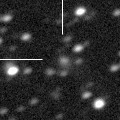
|
Now it is 16.9 mag (Feb. 13, Toshihiko Ikemura, Hirohisa Sato). It was observed at 17 mag in 2017. It will be observable at 18 mag in 2018.
Date(TT) R.A. (2000) Decl. Delta r Elong. m1 Best Time(A, h)
Feb. 17 15 5.19 -19 11.8 5.969 6.197 98 17.8 5:19 ( 0, 36)
Feb. 24 15 5.66 -18 37.3 5.867 6.211 105 17.8 4:52 ( 0, 36)
|
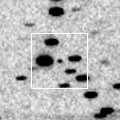
|
Now it is 17.9 mag (Jan. 18, Toshihiko Ikemura, Hirohisa Sato). It will brighten up to 17 mag and will be observable in good condition in spring.
Date(TT) R.A. (2000) Decl. Delta r Elong. m1 Best Time(A, h)
Feb. 17 13 10.50 -13 38.9 1.880 2.591 126 18.0 3:24 ( 0, 41)
Feb. 24 13 11.49 -13 52.1 1.802 2.581 133 17.8 2:58 ( 0, 41)
|
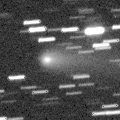
|
It brightened up to 12.2 mag in August (Aug. 21, Juan Jose Gonzalez). It is fading now. It has already faded down to 17.5 mag (Feb. 13, Toshihiko Ikemura, Hirohisa Sato).
Date(TT) R.A. (2000) Decl. Delta r Elong. m1 Best Time(A, h)
Feb. 17 7 12.20 20 54.6 1.841 2.665 138 17.8 21:23 ( 0, 76)
Feb. 24 7 10.87 21 26.3 1.962 2.719 131 18.1 20:54 ( 0, 76)
|
|
![]()
 C/2010 U3 ( Boattini )
C/2010 U3 ( Boattini ) C/2016 T3 ( PanSTARRS )
C/2016 T3 ( PanSTARRS ) C/2014 OE4 ( PanSTARRS )
C/2014 OE4 ( PanSTARRS ) 30P/Reinmuth 1
30P/Reinmuth 1 66P/du Toit
66P/du Toit C/2015 XY1 ( Lemmon )
C/2015 XY1 ( Lemmon ) 90P/Gehrels 1
90P/Gehrels 1 145P/Shoemaker-Levy 5
145P/Shoemaker-Levy 5 103P/Hartley 2
103P/Hartley 2 235P/LINEAR
235P/LINEAR C/2018 A3 ( ATLAS )
C/2018 A3 ( ATLAS ) C/2017 D3 ( ATLAS )
C/2017 D3 ( ATLAS ) C/2017 E3 ( PanSTARRS )
C/2017 E3 ( PanSTARRS ) 143P/Kowal-Mrkos
143P/Kowal-Mrkos 217P/LINEAR
217P/LINEAR![]()






































